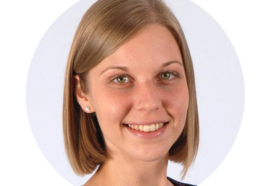Video abstract from Dr. Ellen Verhoef and Dr. Beate St Pourcain on their JCPP paper ‘The developmental origins of genetic factors influencing language and literacy: Associations with early‐childhood vocabulary’.
Authors; Ellen Verhoef, Chin Yang Shapland, Simon E. Fisher, Philip S. Dale, Beate St Pourcain
First published: 14 September 2020
doi.org/10.1111/jcpp.13327
Transcript
Dr. Ellen Verhoef: Welcome to the video abstract of the developmental origins of genetic factors influencing language and literacy associations with early childhood vocabulary that was published last year in the Journal of Child Psychology and Psychiatry. I am Ellen Verhoef and I will guide you through our findings together with Beate St Pourcain. Observational studies show that early language skills are predictive of later cognitive development, such as reading skills but also non-performance intelligence and educational outcomes at the end of primary school. These associations may arise due to shared aetiologies, as proposed by the simple view of reading theory.
The generalist genes hypothesis proposes that these shared aetiologies are also reflected in the genetic architectures of cognition related traits with shared genetic factors amongst cognitive abilities. Heritability of cognition related traits, including language and literacy related skills, tends to increase during development. One way to interpret this increase is in terms of innovation and amplification. Previous studies on cognitive abilities, as well as language and reading skills found that predominantly innovation processes account for the increase in heritability observed in the transition from early to middle childhood.
These studies were, however, exclusively based on latent factortwin modelling.
Dr. Beate St Pourcain: Here we investigated whether genetic factors contributing to language, literacy and cognition in childhood and early adolescence already relate to genetic factors underlying vocabulary skills in early childhood, or whether these genetic factors emerge during the course of development. We studied genetic architectures using genetic marker information in a sample of unrelated children as captured genotyping chips. Specifically the investigative genetic factors related to expressive and for the first time also receptive vocabulary at three years of age and examined multivariate genetic relationships with respect to a wide spectrum of later life skills.
Dr. Ellen Verhoef: We studied children and adolescents with genotyping and behavioural data from the Avon Longitudinal Study of Parents and Children, a UK based longitudinal pregnancy ascertained birth cohort. About 6,000 children had data on early vocabulary at 38 months assessed using parental reports based on the MacArthur-Bates Communicative Development Inventories. In addition to early language phenotypes, we studied 14 traits that were directly assessed in children and young adolescents between the age of seven and 13 years using standardised and ALSPAC-specific psychological instruments.
Dr. Beate St Pourcain: The heritability for early vocabulary was modest, with estimates of 18% and 12% for expressive and receptive vocabulary scores respectively. In comparison, SNP heritabilities for later phenotypes were moderate reaching up to 54%. These findings are consistent with an increase in heritability across development, as previously reported in the literature. At the phenotypic level both expressive and receptive vocabulary scores are related with later verbal and cognitive child and adolescent traits investigated. At the genetic level, however, evidence for shared genetic factors with later life abilities were only observed for receptive vocabulary. Expressive vocabulary was only related to later life verbal IQ.`
Dr. Ellen Verhoef: Next, we modelled multivariate genetic variances between expressive and receptive vocabulary at 38 months, and, in turn, each of the 14 mid childhood, early adolescent traits using genetic relationship matric structural equation models. This method models genetic links between traits based on data from unrelated individuals using genetic relationship matrices derived from genome-wide SNP
information. We fitted Cholesky decompositions to each trivariate model containing three genetic and three residual factors explaining all phenotypic information. This is also known as a saturated model.
Dr. Beate St Pourcain: Here I will talk you through our findings based on a structural equation model for early vocabulary and verbal IQ. On the left side of the slide, the path diagram will appear with arrows indicating which genetic factor is related to which trait, known as factor loading. Square boxes represent the observed phenotypes and circles represent genetic and residual factors. On the right side of the slide, a diagram detailing the estimated variance explained by each genetic factor will appear. The orange boxes in this plot represent the total SNP heritability.
The first genetic factor A1 explains 17% of the variation in expressive vocabulary at 38 months, but also 9% of the variation in receptive vocabulary and verbal IQ. The second genetic factor A2, which is independent of A1, explained the remaining genetic variance in receptive vocabulary which is only 4%. In contrast, the variance that this factor explains in verbal intelligence increases dramatically, reaching 45%. As the bar code already indicated, there was little evidence for a genetic factorthat was only related to verbal IQ.
This pattern suggests that early genetic influences are stable and amplified across development.
Dr. Ellen Verhoef: We followed up work from this paper in a new manuscript that was recently published in PLOS Genetics, where we further investigated genetic links between mid-childhood abilities and early vocabulary assessed between 15 and 38 months. This analysis showed that at least two different genetic factors contribute to phenotype variation in mid-childhood and are amplified during development. The earliest genetic factor that was related to mid-childhood skills was already detectable at the age of 24 months, in addition to genetic influences that are unique to receptive vocabulary at 38 months, consistent with our earlier findings. For performance intelligence, on the other hand, we only observed robust evidence for shared genetic variance with receptive vocabulary. This suggests that the genetic foundations of mid-childhood reading and cognitive abilities are diverse and may differ for verbal and non-verbal traits.
Dr. Beate St Pourcain: Together, our findings suggest that the developmental origins of genetic factors contributing to mid-childhood and early adolescent language literacy and cognition lie in early childhood, consistent with genetic stability. We found evidence for an amplification of early genetic influences. These genetic influences are predominantly, but not exclusively, related to receptive vocabulary. Also, genetic factors that are related to early expressive vocabulary contribute to variation in later reading and verbal cognitive skills. The observed amplification patterns might be due to genotype-environment correlations, different effects of the same genes over time and/or reduced measurement error.
Furthermore, our findings suggest that the developmental origins of genetic factors influencing later life skills are diverse. They only partially support the generalist genes hypothesis. Similar to other studies of unrelated individuals, a general limitation of this work is that our results might be confounded by population stratification, assortative mating and/or indirect genetic effects. In addition, these analysis were all based on ranktransformed scores to allow for comparison of different psychological instruments and data distributions.
With this, we would like to conclude and thank all co-authors, participants and researchers related to ALSPAC as well as the Max Planck Society for funding us, and JCPP for providing us with the opportunity to communicate our research in this short talk.
Thank you very much

Dr. Ellen Verhoef – In 2016 I obtained a Msc in Medical Biology with honors from the Radboud University in Nijmegen. After this, I started a PhD in the population genetics of human communication group, one of the themes embedded in the Language and Genetics department. During my PhD, I will study the role of common genetic variation in early language under supervision of Dr. Beate St Pourcain and Prof. Dr. Simon E. Fisher. One of the aims of my PhD is to discover single genetic variants influencing early vocabulary (15-38 months). This work is part of the EAGLE consortium. In addition to this, I am interested in the genetic architecture of language and literacy across development. In this work I focus on questions as, for example, do genes influencing early vocabulary also influence reading skills later on. Finally, I am studying genetic overlap between early language and neurodevelopmental disorders, such as Autism Spectrum Disorder and Attention-Deficit/Hyperactivity Disorder. Bio and image via Max Planck Institute for Psycholinguistics
Dr. Beate St.Pourcain is a lecturer in Genetic Epidemiology within the School of Oral and Dental Sciences and affiliated with the MRC Integrative Epidemiology Unit. Her interests are the genetic underpinnings of neuro-developmental and developmental phenotypes. This includes autism and autistic traits, early language development and cleft lip and/or palate, where aetiological factors are likely to play a role very early during development. She is leading the genetic research of the Cleft Collective Cohort Studies, a large collection of patients with CL/P and their families, and is involved in the analysis of Next-Generation sequencing data as part of the UK10K Cohorts projects (lead analyst for head circumference). Bio via University of Bristol, image as above.



